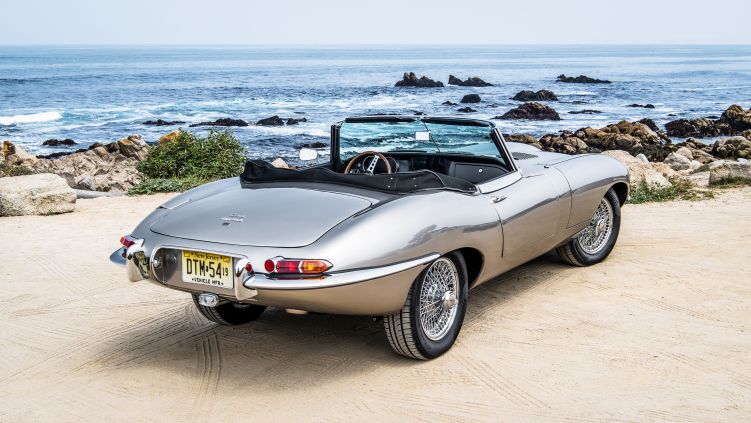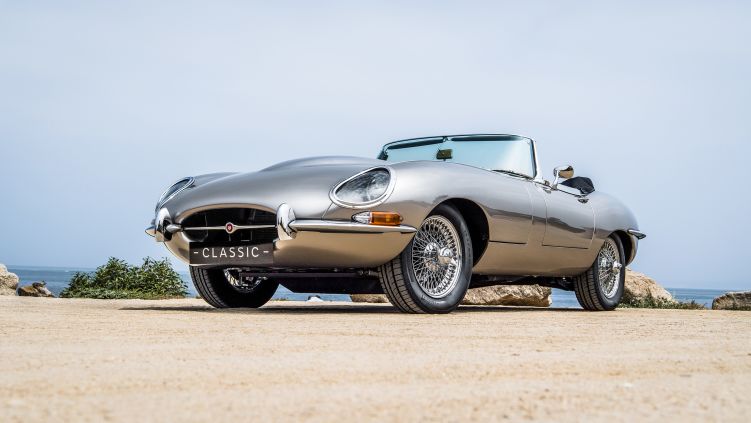The sporty 2018 Jaguar gets a makeover ‘retro-electro’ style
The car industry seems to be spending an increasing amount of effort doing irrational things these days. On the face of it, few of those are further off the reservation than the idea of expensively removing the soul-defining six-cylinder engine from an early E-Type and replacing it with an almost entirely silent electric powertrain.
It’s up there with taking the vocal chords from an opera singer, or the foot off a champion goal-kicker. But it’s what Jaguar’s in-house Classic Division has done.
Firstly, with the E-Type Zero concept that showed off the idea last year and now with confirmation it will be selling the conversion alongside its officially restored Reborn E-Types. Hence, the invitation to have a (limited) go in the demonstrator at the Monterey Car Week in California.
There’s more backstory. There was also an electric Jaguar E-Type at the marriage of Prince Harry and Meghan Markle, the newly minted Duchess of Sussex, being driven to her wedding reception in it. JLR won’t confirm it, but apart from a change of colour from blue to silver, the demonstrator appears to be the same car.

Jaguar Classic admits the idea of an electric restomod isn’t going to appeal to all. Director Tim Hannig says the decision to move to limited-run production has been driven by genuine interest in the idea, not just JLR’s desire to show off its growing EV credentials. And it’s not just the affluent virtue-signallers you might expect to sign up to a non-combusted classic. Apparently, several expressions of serious interest have come from existing E-Type owners wanting something similar but different.
The new powertrain is certainly clever, being an effectively modular unit that has required minimal changes to be made to the base E-Type. The batteries and 190kW motor occupy the same space formerly occupied by the E-Type’s 3.8-litre straight-six engine and four-speed manual gearbox.
More impressive, weight is close to identical as well – Jaguar says the total mass of the whole EV system comes in at under 300kg, less than the ‘XK’ engine it replaces (although that difference will be mostly negated by the need to add a heating system to production versions).
The demonstrator’s control electronics are located under the boot floor, meaning it loses its spare wheel and its charging port has been hidden under the original fuel filler flap.
All the other mechanical parts are pretty much unchanged from the base car, with the Zero using the same suspension, brakes and even rear axle – the e-motor turns the original differential through a single-speed reduction transmission. Jag even claims the whole package is reversible and offers to help buyers store the original engine and transmission of the donor car in case they ever want to swap back.

The prototype powertrain was designed with the help of Croatian EV supercar builder Rimac, but Hannig says that the production version will use a 40kWh battery pack closely related to that in the Range Rover P400E PHEV, with twice as many cells and a higher energy density. This is claimed to be able to deliver up to 320km of range in optimum conditions, with a realistic real-world total of around 250km.
The battery won’t support fast charging, which would have brought the need for active cooling and would have added too much weight, meaning a recharge time of around five hours from a 7kW charger. Given the car’s likely light duty cycle, that’s unlikely to be a major issue.
The cabin is as tight-fitting as that of any other E-Type. People were smaller in 1961, or maybe they just complained less. The prototype has been given a carbon-fibre dashboard and digital instrument pack, as well as a central touchscreen. The plan is to offer production versions with the option of a far more traditional cabin, which sounds like a good idea.
Read more: Jaguar news, reviews, comparisons and videos
Wipers and headlights are controlled by modern toggle switches, but the Zero still uses the original E-Type’s wand-like indicator stalk and has the original steering wheel.
The prototype lacks any kind of heating or ventilation system – production versions will get one, including the option of air-conditioning. The equally heretical notion of electric power steering is also likely to be offered.
My test is a gentle one, rather than an attempt to confirm Jaguar’s claims that the Zero is as quick as the original E-Type. We’re promised a sub-7sec 0–100km/h time.

I’ve got the streets of downtown Monterey, a total route of around 10km and a chaperone sitting in the passenger seat, so there’s no chance to discover how the battery pack will handle the heat-management challenges of harder use.
The first surprise is the important one: the lack of an internal combustion soundtrack doesn’t instantly ruin the E-Type. The near silence of the e-motor is nothing like as good as the original engine’s combination of exhaust rasp and carburettor snort, of course. But even without the acoustic mask of a brawny six, the Zero had none of the squeaking or creaking I would expect to find from a 50-something-year-old Jaguar roadster.
With full torque practically from rest, performance is effortless, the Zero gathering pace in convincing fashion without using more than a couple of centimetres of the throttle pedal’s long travel, and acceleration delivered with a muted whine.
There’s no traction or stability control, which could make things more interesting on low-grip surfaces, although the motor’s peak output can be inhibited through the infotainment system. But even a couple of deliberately hard launches don’t get the rear tyres complaining. Given a wide, open space, I suspect it would be thoroughly hoonable …
Seamless power delivery aside, the rest of the experience is pretty much exactly as I remember more traditional old Jaguars feeling. The ride is soft, and even modest cornering loads produce the sensation of my backside sliding across the leather seats. The unassisted steering is low geared and heavy at manoeuvring speeds, but becomes chatty with feedback once on the move.
The brake pedal has a slight mushiness to the top of its travel, but the Zero stops well enough from real-world speeds. The prototype has no regenerative braking due to the risk of this causing problems in the unlikely event of it being driven in snow or ice, given the lack of ABS.

Is the E-Type Zero as good as an actual E-Type? Of course not and the incongruity of its muted soundtrack shows just how much of our perception of automotive soul is tied up with the dirty business of suck, squeeze, bang, blow. But it is an impressively well-engineered thing, with the modular electrical powertrain set to be rolled throughout Jaguar’s other greatest hits over time – the XK engine was in production up until the 1990s.
Buyers can either provide their own donor vehicle, with Jaguar Classic quoting a £60,000 (AU$100,144) price for a straight powertrain conversion, or alternatively let the company source an original donor car to be rebuilt to a new owner’s exact specification.
Click on the Photos tab for more images of the stunning Jaguar E-Type Zero.








 Proudly Australian owned and operated
Proudly Australian owned and operated